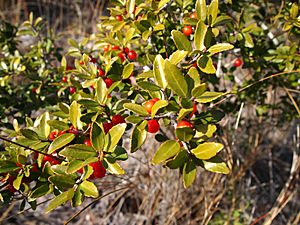Yaupon facts for kids
Quick facts for kids Yaupon |
|
|---|---|
 |
|
| Foliage and fruit | |
| Conservation status | |
| Scientific classification | |
| Genus: |
Ilex
|
| Species: |
vomitoria
|
 |
|
| Natural range | |
The yaupon holly (scientific name: Ilex vomitoria) is a special type of holly plant. It grows naturally in the southeastern parts of North America. The name yaupon comes from the Catawban word yą́pą, which means "tree leaf." Another common name for this plant is cassina.
For a long time, Native Americans used yaupon holly to make a special drink. This drink contained caffeine, just like coffee or tea! Yaupon is one of only two plants found only in North America that naturally produce caffeine. The other is called dahoon holly (Ilex cassine). Today, yaupon holly is also a popular plant for decorating gardens and parks.
The Latin part of its name, vomitoria, comes from an old misunderstanding. Early Europeans thought the plant caused people to vomit during certain Native American ceremonies. However, this was not true. The vomiting was likely caused by drinking very large amounts of the beverage, often combined with fasting.
Contents
What Does Yaupon Holly Look Like?
Yaupon holly is an evergreen plant, meaning its leaves stay green all year round. It can grow as a shrub or a small tree, reaching about 5 to 9 meters (16 to 30 feet) tall. Its bark is smooth and light gray, and its young branches are a bit hairy.
The leaves of the yaupon holly are shiny and dark green on top, and a little lighter underneath. They are small, usually 1 to 4.5 centimeters (about 0.4 to 1.8 inches) long. The edges of the leaves are slightly wavy or toothed.
In spring, yaupon holly produces tiny white flowers, about 5 to 5.5 millimeters (0.2 inches) wide. After the flowers, small, round, shiny red berries appear. These berries are about 4 to 6 millimeters (0.16 to 0.24 inches) across and contain four tiny seeds. Birds love to eat these berries, which helps spread the plant's seeds.
Where Does Yaupon Holly Grow?
Yaupon holly is found in the United States, from Virginia down to Florida, and west to Oklahoma and Texas. There's also a separate group of these plants far away in Mexico, in a state called Chiapas.
This plant usually grows in sandy areas near the coast. You can find it on the edges of salty marshes, sandy hills, and coastal sand dunes. It also grows in well-drained forests and pine areas.
Yaupon Holly and Wildlife

The bright red berries of the yaupon holly are a very important food source for many different birds. Birds like Florida ducks, American black ducks, mourning doves, wild turkeys, cedar waxwings, eastern bluebirds, and American robins all enjoy eating these berries.
Mammals also eat the fruit, including nine-banded armadillos, American black bears, gray foxes, raccoons, and skunks. Even white-tailed deer like to munch on the leaves and twigs of the yaupon holly.
How People Use Yaupon Holly
Yaupon Holly as a Drink
For hundreds of years, Native Americans brewed the leaves and stems of yaupon holly to make a special tea. This tea was sometimes called asi or the black drink. It was often used in important ceremonies for purification and unity.
As mentioned before, the Europeans mistakenly thought the plant caused vomiting. However, the yaupon plant itself does not cause vomiting. The drink contains natural stimulants like caffeine, theobromine, and theophylline. The vomiting during ceremonies was likely due to drinking very large amounts of the strong brew, especially after fasting.
Native Americans might have also used the yaupon tea as a mild laxative. Today, people in the United States are rediscovering yaupon tea. You can now buy commercially prepared yaupon tea in stores.
Yaupon Holly in Gardens
Yaupon holly is a very popular plant for landscaping in the southeastern United States. Gardeners love it because it's an evergreen plant with thick leaves. It can be easily trimmed into different shapes, making it perfect for hedges.
There are many different types of yaupon holly that people grow, called "cultivars." Some popular ones include:
- 'Folsom Weeping' and 'Grey's Weeping' – These types have branches that hang down, giving them a "weeping" look.
- 'Nana' or 'Compacta' – This is a dwarf type that stays small, usually less than 1 meter (3 feet) tall.
- 'Schilling's Dwarf' or 'Stokes Dwarf' – Another dwarf type, this one is male and grows no more than 0.6 meters (2 feet) tall.
- 'Will Fleming' – This type grows tall and narrow, like a column.
- 'Pendula' – This is another "weeping" variety, and it's known to have the highest caffeine content!


